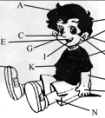根据句意及首字母提示,完成下列单词的拼写。1. I always ride my bike to the s______ station. 2. It t______ me half an hour to do my homework yesterday. 3. My -八年级英语
I had a word with Julia this morning.今天早晨,我跟茱莉雅说了几句话。
He smoked many cigarettes a day until he gave up. 他没有戒烟的那阵子,抽烟抽得可凶了。
(2) 一般过去时常与表示过去的时间状语或从句连用,如:
yesterday,last week ,in the past ,in 1993,at that time,once,during the war,before,a few days ago,when 等等.
(句子中谓语动词是用一般过去时还是用现在完成时,取决于动作是否对现在有影响)。
Have you had your lunch? 你吃过午饭了吗?(你现在不饿吗?)
Yes,I have. 是的,我已经吃过了。(已经吃饱了,不想再吃了。)
When did you have it? 你是什么时候吃的?(关心的是吃的动作发生在何时。)
I had it about ten minutes ago. 我大约是十分钟以前吃的。)
Used to do something 表示过去常做而现在已经停止了的习惯动作。
I used to work fourteen hours a day. 我过去常常一天干十四个小时。
I ate it at 6:45。我在六点四十五分吃了。
(3)带有确定的过去时间状语时,要用过去时。如:
yesterday(昨天)、two days ago…(两天前…… )、last year…(去年…)、the other day(前几天)、
once upon a time(很久以前)、 just now(刚才)、in the old days(过去的日子里)、before liberation(解放前…)、
When I was 8 years old(当我八岁时…)、at+一个时间点
Did you have a party the other day?前几天,你们开了晚会了吗?
Lei Feng was a good soldier.雷锋是个好战士。
注:在谈到已死去的人的情况时,多用过去时。
(4)表示过去连续发生的动作时,要用过去时。这种情况下,往往没有表示过去的时间状语,而通过上下文来表示。
The boy opened his eyes for a moment,looked at the captain,and then died.
那男孩把眼睛张开了一会儿,看看船长,然后就去世了。
(5)表示过去一段时间内经常或反复的动作。常与always,never等连用。
Mrs. Peter always carried an umbrella.彼得太太过去老是带着一把伞。
(只是说明她过去的动作,不表明她现在是否常带着伞。)
比较:
Mrs. Peter always carries an umbrella.彼得太太老是带着伞。
(说明这是她的习惯,表明她现在仍然还习惯总带着一把伞)
Mrs. Peter is always carrying an umbrella.彼得太太 总是带着一把伞。
(表示说话者对这一动作或行为厌烦)
I never drank wine.我以前从不喝酒。
(不涉及到现在,不说明现在是否喝酒)
(6)如果强调已经终止的习惯时要用 used to do(过去常常做,而现在不那样做了)
He used to drink alcohol.他过去喝酒。
(意味着他现在不喝酒了。喝酒这个动作终止了)
I used to take a walk in the morning.我过去是在早晨散步。
(意味着现在不在早晨散步了)
比较:
I took a walk in the morning.我曾经在早晨散过步。
(只是说明过去这一动作)
(7)有些句子,虽然没有表示过去确定时间的状语,但实际上是指过去发生的动作或存在的状态的话,也要用过去时。
I didn''t know you were in Paris.我不知道你在巴黎。
(因为在说话时,我已经知道你在巴黎了。这句话指的是说话之前,所以只能用过去时表示。实际上,这句话暗指:But now I know you are here.)
I thought you were ill.我以为你病了呢。
(这句话应是在说话之前,我以为你病了。但是现在我知道你没病)
一变:肯定句变为否定句
技巧1.当句中含有情态动词或助动词could,would,should等时,可直接在其后面加not构成否定句。例如:
I could get you a concert ticket. → I could not / couldn't get you a concert ticket.
技巧2.当句中含有系动词was,were 时,可直接在其后加not构成否定句。例如:
I was on the Internet when you called me. → I was not / wasn't on the Internet when you called me.
技巧3.当句中谓语是除情态动词、助动词、系动词was, were以外的动词时,在该动词之前加did not / didn't,动词还原,构成否定句。例如:
The famous singer sang some Chinese songs. → The famous singer did not / didn't sing any Chinese songs.
二变:陈述句变为一般疑问句
技巧1.移动词语的位置。将was,were, could,would,should等移到句首。例如:
He could pack his things himself. → Could he pack his things himself?
技巧2.添加助动词did。谓语是除情态动词、助动词、系动词was, were以外的动词时,在主语之前加did,动词还原。例如:
Mr Li looked very old. → Did Mr Li look very old?
三变:陈述句变为特殊疑问句
技巧1.确定疑问词:人who / whom,物what,地点where,时间when / what time,原因why,频率how often,长度how long,距离how far等等。例如:
They gave the concert last night. → When did they give the concert?
技巧2.辨认结构形式:疑问词+情态动词/助动词/ was / were / did +主语+...? 例如:
The accident happened near the station. → Where did the accident happen?
- 最新内容
- 相关内容
- 网友推荐
- 图文推荐
上一篇:选出使用正确的单词或短语。( )1. A: I'm (hot / thirsty).B: You should (drink / eat) a banana smoothie. ( )2. A: (Can /Do) you make a banana smoothie?B: No, -八年级英语
下一篇:根据句子内容和所给的音标,填写一个适当的词。1. It takes about fifteen ______ /minit/ by car. 2. He was ______/il/ yesterday. 3. Canada is in ______ /n/Ameri-八年级英语
零零教育社区:论坛热帖子
| [家长教育] 孩子为什么会和父母感情疏离? (2019-07-14) |
| [教师分享] 给远方姐姐的一封信 (2018-11-07) |
| [教师分享] 伸缩门 (2018-11-07) |
| [教师分享] 回家乡 (2018-11-07) |
| [教师分享] 是风味也是人间 (2018-11-07) |
| [教师分享] 一句格言的启示 (2018-11-07) |
| [教师分享] 无规矩不成方圆 (2018-11-07) |
| [教师分享] 第十届全国教育名家论坛有感(二) (2018-11-07) |
| [教师分享] 贪玩的小狗 (2018-11-07) |
| [教师分享] 未命名文章 (2018-11-07) |






